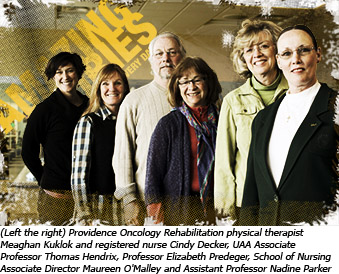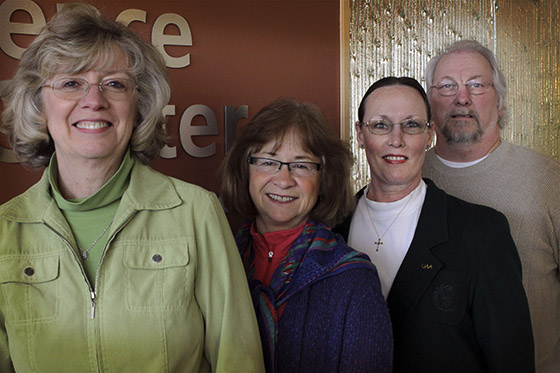Sharing expertise: School of Nursing faculty evaluate Providence Oncology Rehabilitation
by Ted Kincaid |
 School of Nursing (SON) faculty members and students are no strangers to Anchorage
hospitals, clinics and other health care settings where students gain real-world nursing
experience each semester. With the Anchorage campus part of the U-Med district, additional
partnerships between UAA and Providence Health & Services Alaska just make good sense.
Recently SON Associate Director Maureen O'Malley, along with three colleagues, Professor
Elizabeth Predeger, Associate Professor Thomas Hendrix and Assistant Professor Nadine
Parker, partnered with Providence Oncology Rehabilitation to track patient satisfaction
and outcomes in a combined qualitative and quantitative study.
School of Nursing (SON) faculty members and students are no strangers to Anchorage
hospitals, clinics and other health care settings where students gain real-world nursing
experience each semester. With the Anchorage campus part of the U-Med district, additional
partnerships between UAA and Providence Health & Services Alaska just make good sense.
Recently SON Associate Director Maureen O'Malley, along with three colleagues, Professor
Elizabeth Predeger, Associate Professor Thomas Hendrix and Assistant Professor Nadine
Parker, partnered with Providence Oncology Rehabilitation to track patient satisfaction
and outcomes in a combined qualitative and quantitative study.
An SON faculty member familiar with Providence Oncology Rehabilitation suggested the facility for a possible partnership. Nadine Parker-part of a SON scholarship group that included O'Malley, Predeger and Hendrix who were all looking for more research opportunities with local facilities-walked over and introduced herself to the SON neighbors in the Oncology Rehabilitation Center and, just like that, a new partnership was born.
"Providence has been so supportive," says O'Malley. "The nurse and physical therapist over at the rehab center have been very involved in looking at our research and our conclusions. They have been so helpful and so willing to let us academics work with them in their world."
The team spent several months developing a mixed-methods survey for patients who had completed the 10-week oncology rehabilitation program, which combines exercise, education and relaxation techniques, all under the expert guidance of a registered nurse and physical therapist.
What they found in the 102 surveys returned out of 215-a 47.4 percent response rate-was an overarching narrative affirmation: "I have my life back."
"Forty-seven percent, that's a very good response rate for a mailed survey," notes O'Malley. "Their patients are very loyal to them."
Betty Predeger, lead researcher on the project, and her team were somewhat surprised to see that respondents noted a significant increase in physical activity from pre-cancer diagnosis to the time of response. So not only did the program help to up activity levels in cancer survivors during and after cancer treatments, when their activity levels are at their lowest, but it helped to improve their activity levels beyond what they'd been prior to being diagnosed with cancer. And program completers had maintained that increased activity level well beyond "graduation" from the program, in some cases, for two to three years after completion.
The team coded the survey results-both quantitative charts and graphs and qualitative narrative responses to open-ended questions-and shared the results with Providence.
Methods and implications
O'Malley explains the team's choice to use mixed methods: "You can have numbers that say what works or doesn't work, but then it's nice to have that qualitative information that will help to see how it works or why it works or if there's an aspect that's frustrating them." Human responses are complex and the mixed methods approach they employed provides a more complete picture.

This research team, although they've completed this study, is just getting started. "This is really the preliminary stage where we're trying to understand the patients and the experience and their needs," O'Malley says. "What works and what doesn't work? We're trying to see what we can do over there that will really make it even better." Working together they could help the program innovate to better serve their clients.
Clinical practice-academic partnerships like the UAA School of Nursing and Providence Onocology Rehabilitation benefit all parties. "[Providence Oncology Rehab staff] are so busy over there with the patients on a daily basis and research is what we do," O'Malley says. In fact, research is a standard part of faculty contracts. Being in the community studying Alaska's health issues and services keeps faculty at the forefront of their fields and underscores UAA's role as Alaska's health campus.
And on a personal level, actively engaging in community research has positive repercussions for faculty. "It makes me a better teacher," O'Malley says. She's able to use surveys and data from her own recent studies to teach nursing research to undergraduate and graduate nursing students.
"The more we conduct research like this, the more we see opportunities for graduate and undergraduate research," O'Malley says. For her undergraduate research class, she keeps a mailing list of nurses throughout the state who work in all kinds of disciplines-public health, hospitals-and she'll send out a request for their most pressing health and health care questions, O'Malley then puts her students to work researching the literature for best practices and shares their responses with her statewide network. Another win-win for clinical practice-academic partnerships in Alaska.
Predeger, O'Malley, Hendrix and Parker have written up their research oncology rehabilitation results and publication in a nursing journal is pending.
 "Sharing expertise: School of Nursing faculty evaluate Providence Oncology Rehabilitation" is licensed under a Creative Commons Attribution-NonCommercial 4.0 International License.
"Sharing expertise: School of Nursing faculty evaluate Providence Oncology Rehabilitation" is licensed under a Creative Commons Attribution-NonCommercial 4.0 International License.














